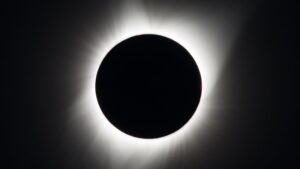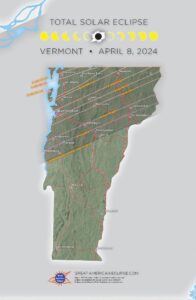April 8th marks the first solar eclipse in Vermont in 7 years and the last until 2044. Better yet, Vermont is in the eclipse’s path of total coverage, expected to hit around 3:30 PM EST!

Vermont is expecting an influx of visitors to see this historical event. While it is incredible to have an extra 100,000+ people in our Green Mountain State, as trail users, managers, and volunteers, we recognize that this event is happening right in the middle of what is typically our Mud Season and when trails are historically closed. We know that some of the best viewpoints are from our amazing trails, but we encourage you, as VMBA members, to spread the word on Mud Season etiquette.
First off, and as always, pay attention to trail closures via Trail Forks, VMBA Chapter’s Conditions Pages, and Trail Finder!
State Lands
The State of Vermont has already announced that trails on State lands will be closed on April 8th due to the projected conditions and risk of damage. A limited number of state parks with some amenities will be open during the eclipse, though the event falls outside of regular operating season.

These include:
- Bomseen
- Boulder Beach
- Branbury
- Crystal Lake
- DAR
- Elmore
- Emerald Lake
- Mt. Philo
- Grant Isle
- Knight Point
- Lake Shaftsbury
- Lake St. Catherine
- Little River
- Niquette Bay
- Silver Lake
- Waterbury Center
Town and Private Land
For trails on town and private land, individual trail managers will determine whether or not trails will be open to the public on April 8th based on conditions. Historically, the vast majority of natural surface trails have been closed in early April, though certain systems at lower elevation and with fast-draining soils may be open. Unless a trail manager is actively promoting visitation during the eclipse – such as the Eclipse Party at Catamount Outdoor Family Center – your best bet is to stay off the trails.
General Advice
While Vermont is no stranger to tourism, the eclipse will see upwards of 100,000+ visitors seeking out viewpoints along a relatively narrow path of totality. And being a half-day drive from over 60 million people, the numbers could be significantly higher. Critically, the vast majority of those viewers will hit the road immediately after the eclipse, which led to multi-hour traffic jams throughout the country following the 2017 eclipse – even in rural areas. So, if you do travel on April 8th, plan on sticking around if you don’t want to be stuck in your car.
In addition to being mindful of traffic concerns, be safe. emergency response services and trailhead access may be compromised on eclipse day, and cell phone coverage in Vermont is not always consistent.
Rather than list out specific recommendations and guidance for the eclipse, we suggest interested folks check out the excellent existing resources that have been published already by the Green Mountain Club, the State of Vermont, Vermont Public, and Vermont Trails and Greenways Council including viewing activities, etiquette, and updates. One particularly excellent and comprehensive resource is this webinar from the Northern Forest Center about planning for the eclipse.
Be smart, be safe, and enjoy this once (or twice) in a generation event!
